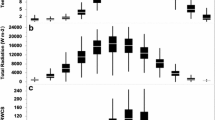Abstract
Heart Lake, a small dimictic lake in Southern Ontario shows classical characteristics of eutrophy: high phytoplankton populations, blooms of blue-greens, predominently Aphanizomenon flos-aquae, in summer, a shallow photic zone decreasing seasonally in response to dense phytoplankton crops and a hypolomnion which is deoxygenated from early summer to fall turnover. Large decreases occur in TDP and SRS in particular, but also in TDN from spring to summer.
The distribution of individual species of algae with depth in the epilimnion was seldom uniform but, more commonly conformed to a definite pattern. The simultaneous existence of different patterns in different species provides evidence of spatial heterogeneity (niche diversification) in the epilimnion, which could lessen any interspecific competition.
Diatom stratigraphy in a 70 cm core revealed that the lake has been eutrophic throughout but may have gone through 3 periods; of these, the most recent one was the most eutrophic and was preceeded by a period of unusually low water levels.
Similar content being viewed by others
References
Armstrong, F. A. & Schindler, D. W., 1971. Preliminary chemical characterization of waters in the Experimental Lakes Area, northwestern Ontario. J. Fish. Res. Board Can. 78: 171–187.
Bryant, G. A., 1975. The auto-ecology of Cyclotella and Melosira species in Southern Ontario lakes. M. Sc. Thesis, Univ. Toronto. 190 p.
Carlson, R. E., 1977. A tropic state index for lakes. Limmol. Oceanogr. 22: 361–369.
Christie, A., 1968. Nutrient-phytoplankton relationships in eight Southern Ontario lakes. Ontario Water Res. Comm. Div. Research Pub. No. 32.
Dunstall, T. G. & Nalewajko, C., 1975. Extracellular release in planktonic bacteria. Verh. Int. Verein. Limnol. 19: 2643–2649.
Duthie, H. C. & Kirton, W. L. Jr., 1970. Primary productivity and standing crops of phytoplankton in Belwood Reservoir. Can. J. Bot. 48: 665–670.
Haney, J. F., 1970. Seasonal and spatial changes in the grazing rate of limnetic zooplankton. Ph. D. Thesis. Univ. Toronto 176 p.
Healey, F. P. & Hendzel, L. L., 1979. Indicators of phosphorus and nitrogen deficiency in five algae in culture. J. Fish. Res. Board Can. 36: 1364–1369.
Holland, R. E., 1968. Correlation of Melosira species with trophic conditions in Lake Michigan. Limnol. Oceanogr. 13: 555–557.
Hutchinson, G. E., 1961. The paradox of the plankton. Am. Nat. 95: 137–146.
Lean, D. R. S., 1973. Phosphorus compartments in lake water. Ph. D. Thesis, Univ. Toronto. 199 p. ba]{au{fnLund}, {gnJ. W. G.}}, {dy1964}. {atPrimary production and periodicity of phytoplankton}. {jtVerh. Int. Verein Limnol.} {vn15}: {pp37–56}.
Lund, J. W. G., Kipling, C. & LeCren, E. D., 1958. The inverted microscope method of estimating algal numbers and the statistical basis of estimations by counting. Hydrobiologia 11: 144–170.
Moss, B., 1972. Studies on Gull Lake, Michigan. 1. Seasonal and depth distribution of phytoplankton. Freshwat. Biol. 2: 289–307.
Nalewajko, C., Dunstall, T. G. & Shear, H., 1976. Kinetics of extracellular release in axenic algae and in mixed algalbacterial cultures: significance in estimation of total (gross) phytoplankton excretion rates. J. Phytol. 12: 1–5.
Nicholls, K. H., Kennedy, W. & Hammett C., 1980. A fish-kill in Heart Lake, Ontario, associated with the collapse of a massive population of Ceratium hirundinella (Dinophyceae). Freshwat. Biol.: 10 (in press.).
Pennington, W., 1943. Lake sediments; the bottom deposits of the north basin of Windermere, with special reference to diatom succession. New Phytol. 42: 1–27.
Reynolds, C. S., 1973. The seasonal periodicity of planktonic diatoms in a shallow eutrophic lake. Freshwat. Biol. 3: 89–110.
Rigler, F. H., 1964. The phosphorus fractions and turnover time of inorganic phosphorus in different types of lakes. Limnol. Oceanogr. 9: 511–518.
Schindler, D. W. & Nighswander, J. E., 1970. Nutrient supply and primary production in Clear Lake, Eastern Ontario. J. Fish. Res. Board Can. 27: 2009–2036.
Sparling, J. H. & Nalewajko, C., 1970. Chemical composition and phytoplankton of lakes of Southern Ontario. J. Fish. Res. Board Can. 27: 1405–1428.
Stainton, M. P., Capel M. J. & Armstrong, F. A. J., 1974. The Chemical Analysis of fresh water. Dept. of the Environment, Fisheries & Marine Service Misc. Special Publ. No. 25. 119 p.
Stockner, J. G., 1971. Preliminary characterization of lakes in the Experimental Lakes Area, Northwestern Ontario, using diatom occurrences in sediments. J. Fish. Res. Board Can. 28: 265–275.
Stockner, J. G. & Benson, W. W., 1967. The succession of diatom assemblages in recent sediments of Lake Washington. Limnol. Oceanogr. 12: 513–532.
Strickland, J. D. H. & Parsons, T. R., 1968. A practical handbook of seawater analysis. 311 p. J. Fish. Res. Board Can. 167.
Vallentyne, J. R., 1969. Definition of a limnologist. Limnol. Oceanogr. 14: 815.
Author information
Authors and Affiliations
Rights and permissions
About this article
Cite this article
Nalewajko, C., Bryant, G. & Sreenivasa, M. Limnology of Heart Lake, Ontario. Hydrobiologia 79, 245–253 (1981). https://doi.org/10.1007/BF00006320
Received:
Issue Date:
DOI: https://doi.org/10.1007/BF00006320




